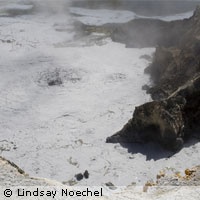Nov 8 2008
Swedish scientists have discovered a novel cell-division mechanism in a microorganism that thrives in hot acid. Their findings, published online in the journal PNAS, may provide valuable insights into cell biology and the evolution of life on Earth.

In contrast to the well-studied cell-division mechanisms of bacteria and other life forms, the cell-division components of the single-celled 'extremophiles' called Crenarchaeota (the most abundant single-celled organisms in the marine environment) have until now not been identified.
Professor Rolf Bernander and colleagues from Uppsala University in Sweden identified the key components of the cell-division system of Sulfolobus acidocaldarius, a single-cell organism originally identified in a hot spring in Yellowstone National Park, US. S. acidocaldarius grows optimally in 80ºC acid, making it a subject of interest for several areas of science.
Crenarchaeota belong to the Archaea domain, which has an evolutionary history and biochemistry assumed to be essentially different from other forms of life. However, most Archaea have not been studied in the laboratory. In contrast, Eukaryotes (animals, plants, fungi and protists, whose cells have a nucleus) are well studied and their cell-division process well known. This process involves the separation of duplicated chromosomes via movements directed by microtubules.
The current study describes the structures that are formed within S. acidocaldarius cells during segregation and division, and shows how certain aspects of the regulation of its cell-division process are reminiscent of that seen in eukaryotes. The similarities the researchers found suggest a common evolutionary origin between these dramatically different life forms.
The scientists demonstrated that a three-gene complex, Cdv, forms part of the unique cell-division machinery of S. acidocaldarius and is activated just before the process begins. The protein products from these genes (Cdv proteins) form a band in the middle of the cell between newly segregated chromosomes. They gradually constrict the cell until two new daughter cells are formed.
'This is the first time in decades that a novel cell-division mechanism has been discovered, and the gene products display no similarity to previously known division proteins,' said Professor Bernander.
The cell-division machinery they found did not resemble bacterial or eukaryotic machineries; however, two of the Cdv proteins involved showed similarities to the 'ESCRT-III sorting complex' in eukaryotes. This sorting complex is part of the protein-sorting machinery required for 'budding events'; it plays an important role in the formation of vesicles within the cell, and is implicated in virus budding of HIV-1.
'The observed analogy between the Cdv system and the eukaryotic ESCRT-III complex is compelling and suggests a shared origin for these systems,' the study concludes.
The findings provide new knowledge of the cell biology of Crenarchaeota, but also contribute to our understanding of key cellular processes in higher organisms. Finding similarities in the evolutionary history of the cell-division processes in these different domains provides fascinating insights into the origins of life in hot environments on early Earth. According to Professor Bernander, the findings also have implications for the search for life in extreme environments on other planets.